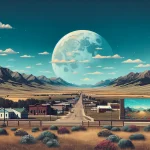Silverton, Colorado, a former silver mining camp, now attracts over 100,000 visitors annually for its stunning natural beauty and recreational opportunities.
In This Article
TL;DR
- Silverton is a historic mining town located in the San Juan Mountains of southwestern Colorado.
- The town is known for its well-preserved Victorian architecture, stunning mountain views, and scenic beauty.
- Silverton offers a variety of outdoor activities, including hiking, biking, skiing, and off-road adventures.
History and Heritage
Founded in 1874, Silverton quickly grew into a bustling mining town during the silver boom of the late 19th century. The town’s colorful history is evident in its well-preserved Victorian-era buildings, many of which now house shops, restaurants, and galleries.
The San Juan County Historical Society operates the Silverton Historic District, which includes several museums showcasing the town’s mining heritage. Visitors can explore the Old Hundred Gold Mine, ride the historic Durango and Silverton Narrow Gauge Railroad, or take a guided tour of the town’s architectural landmarks.
Silverton has been named a National Historic Landmark. One of only 3,000 locations with this designation, it is considered one of the best-preserved historic sites in North America. Greene Street is downtown’s main street and was historically home to merchants, churches, and high-end hotels. On one side were all the respectable establishments, and on the other was the infamous Blair Street, home to saloons and bordellos. It is still a swirl of activity as tourists flock to this area to feel transported back to the Old West and buy some souvenirs.
Outdoor Recreation
Silverton’s location in the heart of the San Juan Mountains makes it a prime destination for any outdoor activity. The town is surrounded by the Weminuche Wilderness, the largest wilderness area in Colorado, offering countless hiking, backpacking, and camping opportunities.
Silverton transforms into a snowy paradise in the winter, with nearby Silverton Mountain offering expert-only skiing and snowboarding. The town also serves as a base for backcountry skiing, ice climbing, and snowmobiling adventures.
During the summer, visitors can enjoy scenic drives on Cinnamon Pass, part of the Alpine Loop Scenic Byway, which connects Silverton to the ghost town of Animas Forks. The area is also popular for off-road adventures, with numerous Jeep and ATV trails winding through the rugged mountain terrain. This road trip follows the Gunnison River, climbs over the Continental Divide for stunning mountain views, and descends to the Animas River.
Companies like the Durango Rivertrippers offer all-day adventure packages that combine a guided rafting trip with a stop in Silverton and a Durango train ride.
Festivals and Events
Silverton hosts several annual festivals and events that showcase the town’s unique character and heritage. The Hardrockers Mining Holiday, held in late summer, features a parade, live music, and a mining competition. It also includes a mining museum tour, gold panning demonstrations, and a historical re-enactment of the town’s early days.
In September, the town celebrates its creativity with the Silverton Creates! Celebration of the Arts, which includes art demonstrations, live music, heritage tours, a maker’s market, a pancake breakfast, and more.
Accommodations and Dining
Silverton offers a variety of lodging options, from historic hotels and inns to vacation rentals and campgrounds. The Grand Imperial Hotel, built in 1883, is popular for its Victorian charm and central location.
The town’s dining scene features a mix of casual cafes, brewpubs, and fine dining establishments. Local favorites include the Avalanche Brewing Company, known for its craft beers and pub fare, and The Pickle Barrel, a historic saloon serving classic American cuisine.
Planning Your Visit
Silverton is located approximately 50 miles north of Durango, Colorado, and is accessible via the scenic Million Dollar Highway (U.S. 550). The town is open year-round, but some businesses and attractions may have limited hours during the winter months.
Visitors should be prepared for high-altitude conditions, as Silverton is at an elevation of 9,318 feet. It is important to stay hydrated, wear sunscreen, and take time to acclimate to the altitude before engaging in strenuous activities.
FAQ
What is the best time of year to visit Silverton?
The best time to visit Silverton depends on your interests. Summer (June-August) in the San Juan Mountain Range is ideal for hiking, biking, and exploring the town’s historic sites. Winter (December-March) is perfect for skiing, snowboarding, and other snow activities.
How do I get to Silverton?
Silverton is located approximately 50 miles north of Durango, Colorado, and can be reached via U.S. Highway 550 (the Million Dollar Highway). Durango-La Plata County Airport (DRO) and Montrose Regional Airport (MTJ) are the nearest airports.
What should I pack for a trip to Silverton?
Pack layers, as temperatures can vary greatly throughout the day. Bring comfortable walking shoes, sunscreen, and a hat for exploring the town and hiking trails. Pack warm clothing, gloves, and a hat for snow activities in the winter.
Are there any guided tours available in Silverton?
Several companies offer guided tours of Silverton’s historic sites, mines, and surrounding wilderness areas. The Durango and Silverton Narrow Gauge Railroad also offers scenic train rides from Durango to Silverton. The ghost town of Animas Forks provides a brochure and map for self-guided tours.
What is the elevation of Silverton?
Silverton is in the San Juan Mountain Range, 9,318 feet (2,836 meters) above sea level. Visitors should be prepared for high-altitude conditions and take time to acclimate before engaging in strenuous activities.






